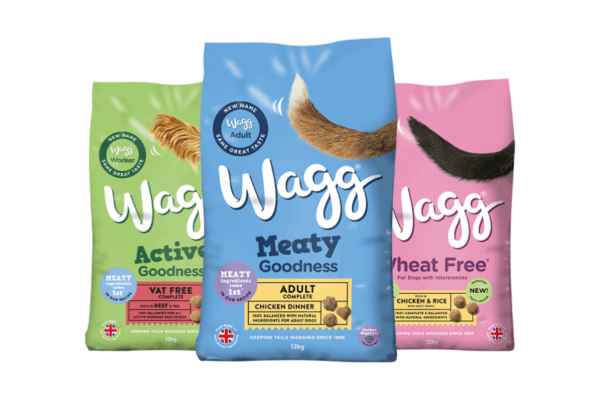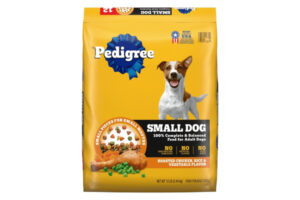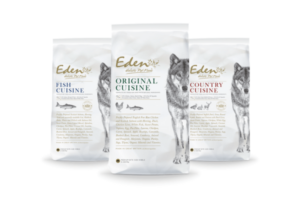If you’re looking for a dog food that won’t break the bank but still provides solid nutrition for your furry friend, Wagg might have caught your eye. This British brand has been around since 1990 and has built quite a reputation in the UK market, especially among budget-conscious dog owners. What sets Wagg apart isn’t just its affordable pricing – it’s actually the first major UK pet food manufacturer to achieve carbon-negative status, which is pretty impressive for a value brand.
I’ve been keeping an eye on Wagg for years, and what strikes me most is how they’ve managed to balance affordability with environmental responsibility. Based in Yorkshire, they produce over 40,000 tonnes of dog food annually while maintaining their commitment to sustainability. The brand is now owned by Inspired Pet Nutrition under CapVest Partners, but they’ve stuck to their original mission of providing “affordable, healthy and nutritious pet food.”
Let me walk you through what you need to know about Wagg – the good, the not-so-good, and whether it’s right for your dog.
What’s in Wagg Dog Food
When you pick up a bag of Wagg, you’re getting a grain-inclusive formula that’s designed to meet FEDIAF nutritional standards. The brand takes a traditional approach to dog nutrition, using ingredients like chicken, wheat, barley, and maize as their foundation. You’ll find chicken listed as the primary protein source in most formulas, though the actual meat content typically ranges between 20-28%.
What I appreciate about Wagg is their transparency about being a cereal-heavy formula. They’re not trying to pretend they’re a high-meat brand – they’re upfront about using grains as a significant portion of their recipes. Each formula includes functional additives like MOS prebiotics (0.1%) for digestive health, yucca extract to reduce stool odor, and omega fatty acids from linseed for skin and coat benefits.
The brand avoids artificial colors, flavors, and added sugars across all their products, which is something I always look for in dog food. However, some formulations do include generic “meat and animal derivatives” as secondary proteins, which isn’t ideal for those who prefer more specific ingredient listings.
Range of Products Available
Wagg offers a comprehensive range that covers most dogs’ needs throughout their lives. Their Complete Puppy formula contains elevated protein levels (20%) and DHA-rich marine oils to support developing brains and immune systems. It’s specifically designed for dogs from 4 weeks through 12 months, which covers that important puppy growth period.
For adult dogs, their standard range features chicken as the main protein with added prebiotics and that yucca extract I mentioned earlier. The Senior formulation is thoughtfully designed with L-carnitine to help older dogs maintain a healthy weight, while their Worker line provides higher calories for active or working breeds.
If your dog has sensitivities, Wagg’s Wheat-Free Sensitive formula uses rice and chicken as primary ingredients, eliminating common allergens like dairy and soy. It includes chicory root as a natural prebiotic source and reduces protein levels to 20% to minimize dietary intolerances. The treat range is quite extensive too, from training treats to dental sticks designed to help reduce tartar buildup.
Sustainability and Environmental Impact
This is where Wagg really shines, and honestly, it’s what sets them apart from most budget brands. Their carbon-negative certification isn’t just marketing fluff – they’ve implemented comprehensive offset programs that cover everything from manufacturing to employee commutes. They’re offsetting 110% of their emissions through verified projects in Kenya, Uganda, the Philippines, Cambodia, and India.
Their sustainability efforts go beyond just carbon offsetting. They’ve partnered with waste-reduction companies to ensure complete recycling of raw materials and packaging, and they’ve even created wildflower meadows at their facilities that attract protected bird species. The dry food packaging is already recyclable, and they’re transitioning their treat packaging to more eco-friendly materials.
I’ve personally seen how much dog owners care about environmental impact these days, and Wagg is genuinely leading the way in this area among affordable brands. However, it’s worth noting that some critics argue offset-reliant carbon claims don’t address the root issue of supply-chain decarbonization, which is a fair point across the industry.
Price and Value for Money
Let’s talk numbers because this is probably why you’re considering Wagg in the first place. A 12kg bag typically retails for £11-£12.50 (around $14-$16), which works out to roughly £0.92-£1.04 per kilogram. That’s approximately 30% cheaper than mid-tier competitors like Harringtons, and significantly less than premium brands.
For large-breed owners or households with multiple dogs, these savings really add up. I’ve spoken with many owners who’ve calculated that feeding a large dog quality nutrition would cost them hundreds more per year with premium brands. Wagg makes decent nutrition accessible, which I think is genuinely important.
The brand is widely available too – you’ll find it in major supermarkets like Tesco and Morrisons, pet stores like Pets at Home, and online retailers. They often run promotions like “3 for £3” on treats, which adds to the value proposition.
Real Owner Experiences
I always pay attention to what real dog owners are saying, and the feedback on Wagg is generally positive with some important caveats. Many long-term users report dogs thriving well into their senior years – I’ve seen testimonials from owners whose dogs lived to 17-19 years on Wagg diets. The palatability seems excellent, with even fussy eaters accepting it well.
The cost efficiency is consistently praised, especially by owners of large breeds or multiple dogs. One owner told me: “For large breeds, food costs accumulate quickly. Wagg makes quality nutrition accessible without compromising on my dog’s health.”
However, there are some criticisms worth noting. Some owners report that the cereal-heavy formulas can cause issues like “weepy eyes, stinky breath and soft smelly stools” in sensitive dogs, which typically resolve when switching to higher-meat alternatives. There are isolated reports of more severe reactions, though these appear to be exceptions rather than the rule.
The Sensitive formula gets mixed reviews – while some owners see improvements in dogs with dietary intolerances, others find the generic “meat and animal derivatives” listing less effective for severely allergic dogs. If you’re dealing with serious food sensitivities, you might want to consider something like dog food from Ava, which offers more specific ingredient listings.
Nutritional Analysis
From a nutritional standpoint, Wagg takes a conventional approach that prioritizes balanced macronutrients from diverse sources. Unlike grain-free, high-meat competitors that emphasize ancestral diets, Wagg employs proven nutrient adequacy through FEDIAF standards. This means your dog is getting complete and balanced nutrition, even if it’s not the most biologically appropriate formulation available.
The protein levels vary by life stage – puppy formulas contain around 20% protein, while adult formulas are typically similar. The inclusion of prebiotics and omega fatty acids shows they’re thinking about digestive health and coat condition, which I appreciate. The yucca extract for odor control is a nice touch that many owners notice.
Where Wagg falls short compared to premium brands is in the meat content and ingredient specificity. While they meet all nutritional requirements, dogs with specific needs or sensitivities might benefit from more targeted formulations with higher meat content and fewer cereals.
What Kind of Dogs is This Food Suitable For
Wagg works best for healthy adult dogs without specific dietary sensitivities whose owners prioritize good value and environmental responsibility. It’s particularly suitable for large-breed dogs where feeding costs can become significant, and for households with multiple dogs where budget considerations are important.
The puppy formula is perfectly adequate for growing dogs who don’t have special requirements, while the senior formula works well for older dogs who need help maintaining a healthy weight. The Worker line is great for active dogs who need higher calories but don’t require ultra-premium nutrition.
If your dog has sensitive skin, digestive issues, or specific food allergies, you might want to start with their Wheat-Free Sensitive formula, though dogs with severe sensitivities might need more specialized options. The brand is also suitable for dogs who are good with grains – if your dog thrives on grain-inclusive diets, Wagg can be an excellent choice.
I wouldn’t recommend Wagg for dogs with serious health conditions requiring therapeutic diets, or for owners who prioritize maximum meat content and minimal processing. It’s also not the best choice if you’re looking for organic or raw-based nutrition.
Final Conclusion
As a dog food specialist, I think Wagg is a solid, honest choice that delivers on its promises without pretending to be something it’s not. It’s not the most premium option available, but it’s far from the worst, and it offers something unique in the budget segment – genuine environmental responsibility.
The nutrition is adequate and meets all regulatory standards, the price point makes quality feeding accessible to more households, and the sustainability credentials are genuinely impressive. Most dogs do well on Wagg, and many thrive on it for years. The brand’s transparency about using cereals and their straightforward approach to nutrition is refreshing in an industry full of marketing hype.
However, if you’re looking for high-meat content, grain-free formulations, or specialized nutrition for dogs with complex health needs, you’ll want to look elsewhere. Wagg is honest about what it is – a nutritionally complete, environmentally responsible, budget-friendly option that works well for most healthy dogs.
My verdict? It’s a good choice for the right dog and the right household. Not groundbreaking, but definitely worthwhile, especially if sustainability and affordability are priorities for you. I’d recommend giving it a try if it fits your dog’s needs and your values.
Find the Perfect Food for Your Dog
Every dog is unique, and so are their nutritional needs. While Wagg might be perfect for some dogs, others might thrive better on different formulations or brands. That’s why it’s important to choose dog food based on what your dog truly needs – their age, size, activity level, and any specific health considerations.
We’ve created a comprehensive questionnaire where you can fill in details about your dog and receive completely free recommendations for the three best dog food brands specifically selected for your furry friend. It takes less than a minute to complete and considers factors like your dog’s breed, age, weight, activity level, and any sensitivities they might have.
You can access our personalized dog food questionnaire via this link. It’s entirely free and will give you tailored recommendations based on your dog’s unique profile, helping you make the best choice for their health and happiness.






